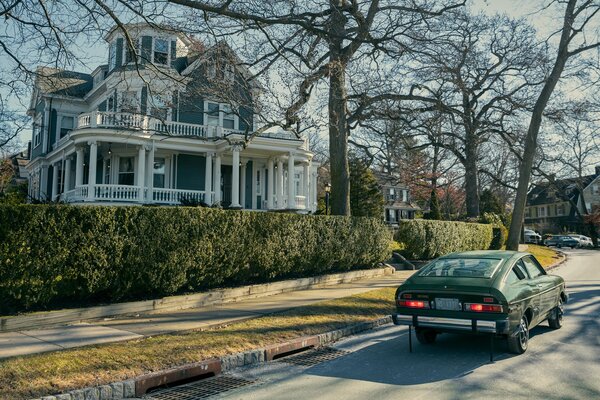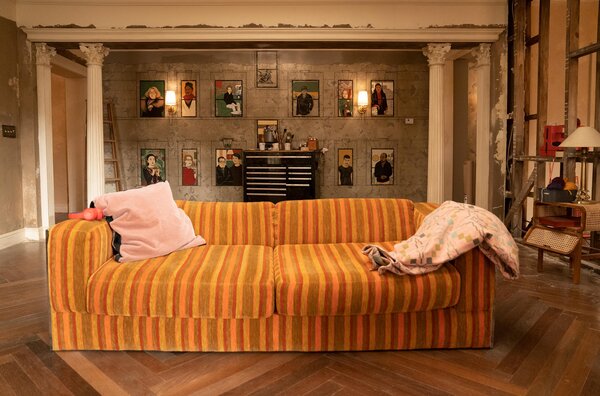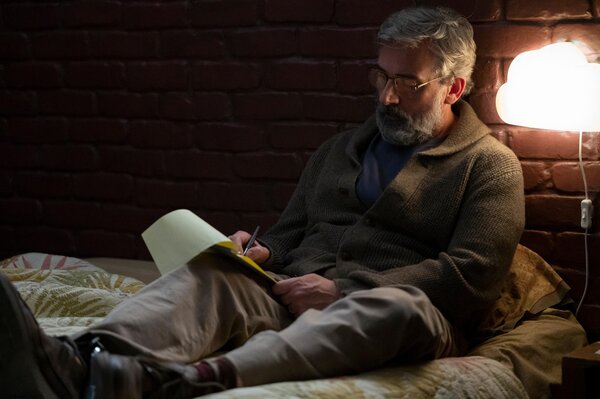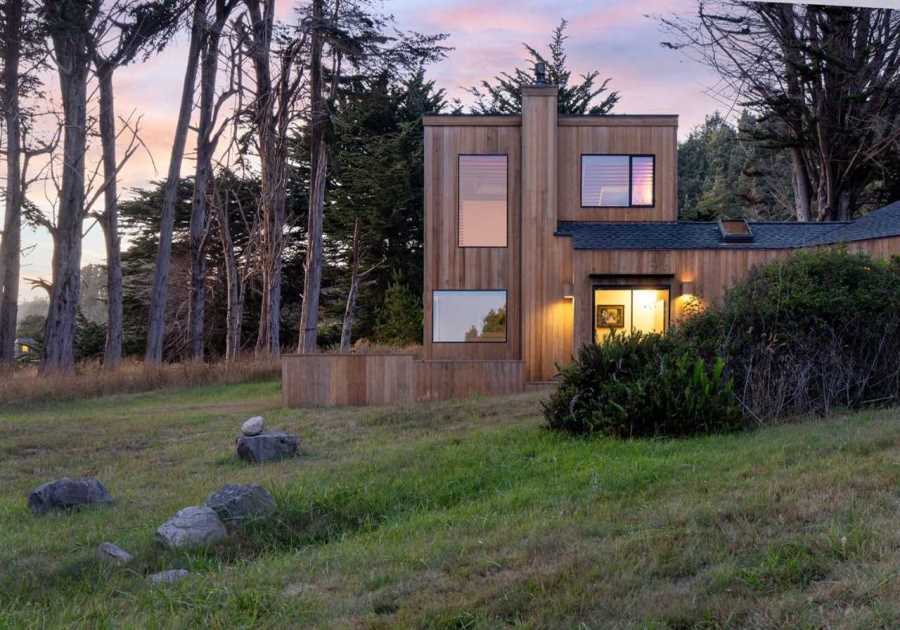In 2022, some of the most memorable houses we saw on non-scripted television were also the most, dare we say it, normal?
The below conversation is a meeting of the minds between executive editor Kate Dries, senior home guide editor Megan Reynolds, and culture editor Sarah Buder about the fictionalized TV homes that grabbed our attention in 2022. Sure, there was plenty of high-end living—cough, The White Lotus: Sicily—but what we’re still thinking about are the people living sort of like us.
Sarah Buder: Okay so I have admittedly not even watched this Netflix series, but I obviously devoured The Cut’s story on the actual ordeal that The Watcher is based on (and then went down my own internet-research rabbit hole, of course). It didn’t require much sleuthing to learn the following: The Brannocks (played by Bobby Cannavale and Naomi Watts) are based on the real-life couple Derek and Maria Broaddus who, just a few days after closing on the mansion at 657 Boulevard in Westfield, New Jersey, started getting mysterious letters signed by "The Watcher" in 2014. In the letters, the anonymous writer said things like, Do you need to fill the house with the young blood I requested? (ew!) and shared plans to learn which rooms the residents would sleep in after their move-in (again, ew). The fictionalized show uses the original home’s actual street address, but the on-screen version is slightly more mansion-y than the New Jersey home the Broadduses moved into. The home used for the show is in another East Coast suburb in New York’s Westchester County, where it’s similarly easy to imagine residents can pop next door to ask their neighbors for sugar when their pantries are out of stock.
While the real New Jersey house, which the Broadduses bought for $1.36 million (so the internet tells me) was built in 1905 with six bedrooms, four bathrooms, and multiple fireplaces, The Watcher gives us a 1921 mansion with four bedrooms, five baths, an attic and basement, and a pool for $3.2 million. (That’s actually quite a bit above what comparable homes in Westfield currently go for, according to a quick Zillow sweep. I digress.)
In the series trailer—because again, I haven’t watched, and will admit I might be too scared to—we see the Brannocks pull up to their sprawling, shingled mansion with a neatly trimmed, very sufficiently watered lawn. The scene screams upper-class suburban idyll. But a few clips later, another shot of the home (a different part of the exterior) looks up at the multi-pane windows from the rose garden. Even before it pans out to reveal the black-gloved hand of a (presumably unwelcome) onlooker, you get the vibe that the looming structure might be more spoiled than it seems. It’s like, maybe you can’t put your finger on why, but you know the house is creepy. And I’m pretty confident that’s not just me having qualms about excessively large homes and suburbia.

The Watcher is based on the true story of a New Jersey family, who, just a few days after closing on their Westfield mansion, started receiving ominous mail from an anonymous letter-writer.
Photo by Eric Liebowitz/Netflix © 2022
Megan Reynolds: While The Watcher is at its heart a psychological thriller about the suburbs and the various cracks in the American Dream, it’s also a show about New Jersey—a state that serves as a stand-in for suburban malaise and a marriage that is in a state of doldrums. And no other show explored the latter more loquaciously than Fleishman Is in Trouble.
Nothing about the interiors in this show are particularly remarkable, which means that the set decorators and prop stylists did a great job. The attention is supposed to be on the hideous breakdown of one man’s marriage and his resulting midlife crisis; if you can tear yourself away from that, then the homes start to come into focus. Toby (Jesse Eisenberg) and Rachel’s (Claire Danes) first New York City apartment is run-down enough to be charming, but not nearly run-down enough to feel accurate. (No water damage from leaky pipes? All the floors appeared to be level? I don’t buy it.) The soulless, new-money blah of their shared home is actually brilliant—it seems cool tones are now an effective visual shorthand for "a lot of money but no taste," and their apartment is all of that and more. It’s a perfect vessel for Rachel’s social-climbing tendencies, and even more so in how its sterile coolness butts up against Toby’s entire essence. Though I’m now making assumptions of a fictional character’s interior life, I get the sense that Toby’s version of "wealth" is different than Rachel’s—and the apartment he’d dream of is more of a rumpled, Upper West Side vibe—the kind of place that you bought when it was affordable and have since filled with tastefully worn-in furniture, many ceramics, kilim rugs bought for a song, and a Wayne Thiebaud print in the kitchen. Yes, those two are wrong for each other in many ways, and their taste reflects it much more so than any long-winded monologue delivered by the effervescent Lizzy Caplan (as Libby) could.
Libby’s rambling house in New Jersey is perfect. Set in a suburb that I presume is supposed to be Maplewood (that town pool was the hint), the house is comfortable, slightly messy, and full of light—a dream for city dwellers sick of working around one closet in a cramped one bedroom somewhere slightly inconvenient. That Caplan’s character feels stifled in what is arguably a large home with many opportunities for privacy makes sense—we always want what we can’t have. (The metaphor is a little heavy-handed, but then, so is the entire show.)
The interior that feels the most realistic is unfortunately the saddest: Toby’s midlife crisis divorcée bachelor pad is dark, full of unresolved memories and trauma, and is decidedly uncomfortable. It’s the kind of place you want to leave the minute you arrive. His kids sleep in twin beds in the same room, the parquet floors need work, and most importantly, the apartment is just a container for his infinite, crushing loneliness. Accurate divorced dad vibes!
SB: And then, this year brought White Lotus: Sicily, where relationships unravel and other crises unfold in an aspirational vacation setting.
Kate Dries: It kind of drove me crazy that the "beach" they filmed at—in Cefalù—is a couple hours away from the actual hotel they filmed at—in Taormina. I understand they wanted a beach club as part of the hotel, and the hotel didn’t have one (because it’s on a cliff) but…that’s just literally two different cities!
"If I ever found myself in danger of having a nervous breakdown, I’d like to do it in this house specifically."
MR: I would gladly live in the cursed palazzo in Palermo, but my real question after watching this show is what do we think the lobby of the White Lotus smells like? Thinking specifically of the fanciest hotel I’ve ever been in, which is the Miami Beach Edition, it smelled so good, and unfortunately, that’s all I think about now when I see or am in fancy hotels and other interiors that I am far too poor for. (If I had to wager a real guess, the White Lotus Sicily’s signature scent is this Cereri Molla candle in Amber + Sandalwood, if only because this is the nicest thing I’ve smelled that isn’t the Miami Beach Edition.)
KD: Speaking of rich people, I didn’t finish Loot, but during the episodes I did view I could not stop focusing on the L.A. mansion Maya Rudolph’s character, Molly, lives in, which is, as Architectural Digest outlines, "thought to be the largest modern residence in the country." It is one of those homes that, if it hadn’t been on Selling Sunset, looks just like a house on Selling Sunset, leaving me mostly trying to figure out if I had seen it on my screen before. (When I realized that was the main draw, I stopped watching.)
Hacks, meanwhile, does an incredible job elevating the Vegas aesthetic, which was executed particularly nicely this year with the addition of Deborah Vance’s (Jean Smart) van being taken on the road for her tour. The gags alone done with the tiny space were worth the price of admission.
MR: I truly could not live with myself if I didn’t mention Deborah Vance’s L.A. mansion, which is perfect to me in every way. There’s a fountain in the grand foyer, there’s black-and-white checkered floors, and a mezzanine, which is an architectural flourish I imagine many people do not like, but I certainly do! If I ever found myself in danger of having a nervous breakdown, I’d like to do it in this house specifically; that big staircase begs for a Norma Desmond moment. But perhaps the funniest—and most realistic—part of this entire setting is Deborah’s anger at the treehouse her neighbors built, which blocks her view from the sunroom. Who among us has not felt irritation at a neighbor’s choices, and who among us has not threatened to do something like, I don’t know, spray-paint the fence that an irritating neighbor put up right on the property line of their father’s backyard, blocking the view of a lovely little hill and a tiny little lot that gets meadow-y in the summer?

In Only Murders in the Building, Mabel Mora (Selena Gomez) lives in apartment 12E of the fictitious prewar Arconia co-op on New York City’s Upper West Side.
Photo by Barbara Nitke/Hulu
SB: Okay, something else I binged this year was Only Murders in the Building (the first and second seasons; I was late to the parade). I have a lot of opinions about how on-the-nose the show is with Mabel’s (Selena Gomez) wounded cool girl who DGAF vibe, starting with the sizable but decrepit apartment where she’s living while renovating it for her aunt. The show’s production designer Curt Beech described Mabel’s apartment as "a visual metaphor for the character"—we’re meant to interpret the unfinished walls and lack of furniture as symbols of Mabel’s identity and self-healing, which, like apartment 12E, are "a work in progress…and that progress has been interrupted." I can get behind this visual symbolism to an extent, but the execution felt…trite. Like, we get that Mabel is the wry, youthful artist to Oliver (Martin Short) and Charles’s (Steve Martin) well-meaning but out of touch father-types, and she’d probably rather live in a Bushwick loft than in the (fictitious) prewar Arconia co-op on the Upper West Side. But some of those walls were literally left open; wouldn’t a building inspector stop by to check out the renovation progress? I’m skeptical.
I was, however, very into the use of loud, colorful wallpaper in some of the other Arconia residents’ apartments. The clashing patterns and decorative lighting fixtures—not to mention the building’s hidden passageways—really leaned into the classic murder mystery aesthetic.

In the psychological thriller miniseries The Patient, a therapist (played by Steve Carrell) is held captive by one his patients, who reveals himself to be a serial killer.
Photo by Suzanne Tenner/FX
See the full story on Dwell.com: A Completely Non-Exhaustive, Highlights-Only Survey of the Year in TV Homes
Related stories:
- From Agatha Christie to ‘Glass Onion’: Why Art Deco Is the Murder Mystery Aesthetic
- You Can Build Anything in the Metaverse, Especially a Déjà Vu-Inducing, Unlivable House
- Trying Not to Be the Grinch About the Holiday Aesthetic
Read More
By: Sarah Buder, Kate Dries, Megan Reynolds
Title: A Completely Non-Exhaustive, Highlights-Only Survey of the Year in TV Homes
Sourced From: www.dwell.com/article/a-completely-non-exhaustive-highlights-only-survey-of-the-year-in-tv-homes-1ed7e5d9
Published Date: Thu, 22 Dec 2022 16:56:03 GMT
.png)





